About This Webinar
Fluorescence imaging is a key technique in both biomedical research and clinical diagnosis. Fluorescence-based microscopy for high-resolution and high-throughput multifluorophore imaging typically relies on the use of several individual laser sources at different wavelengths, within the same instrument.
Removing the complexity of integrating individual lasers with a multi-line solution or laser combiner makes for simpler, more cost-efficient and user-friendly instrumentation, while becoming easier to manufacture and maintain. And as more of the traditionally laboratory-based techniques transition into clinical settings, the need for reliable multicolor laser excitation to provide the imaging quality and speed necessary for clinical use is essential.
Navigating the field of laser-based multicolor excitation options can be challenging. Multi-line lasers, such as the Cobolt Skyra™, provide a permanently aligned and service-free multicolor illumination source with up to four wavelengths in a very compact package. Laser combiners, such as the C-FLEX, provide high power and flexible solutions with up to eight wavelengths and laser technology suitable for multidisciplinary applications, such as combining Raman spectroscopy and fluorescence microscopy. Both options fulfill niches within the landscape of multicolor laser excitation for fluorescence microscopy techniques.
In this webinar, Melissa Haahr and Helge Schmidt, Ph.D., of HÜBNER Photonics discuss the relative advantages of multi-line lasers and laser combiners, introducing the technology behind both solutions, with the aim to help identify the suitability of either solution for applications including light sheet microscopy, SIM, TIRF, STED, confocal microscopy, flow cytometry, and combined techniques.
This webinar will be 40 minutes with time reserved at the end for questions.

An example of an image taken in a single-molecule localization microscopy (SMLM) setup using the Cobolt Skyra multi-line laser from Department of Biotechnology and Biophysics at Julius-Maximilian-University of Würzburg. Courtesy of M. Sauer, Ph.D., University of Würzburg, Germany.
Who should attend:
This webinar is intended for both researchers and instrument manufacturers who are interested in new solutions of lasers for their experiments or instrument design. This includes R&D scientists, engineers, project and production managers, and purchasers who work with laser systems for fluorescence imaging in various applications within biophotonics and medicine.
About the presenters:
 Melissa Haahr is product manager for Cobolt’s lasers for life sciences at HÜBNER Photonics. She holds a master’s degree in physical chemistry from the University of Oregon and bachelor’s degrees in chemistry and environmental science from Alfred University. She joined HÜBNER Photonics in 2014, bringing experience in analytical instrumentation and analysis techniques, as well as in technical sales.
Melissa Haahr is product manager for Cobolt’s lasers for life sciences at HÜBNER Photonics. She holds a master’s degree in physical chemistry from the University of Oregon and bachelor’s degrees in chemistry and environmental science from Alfred University. She joined HÜBNER Photonics in 2014, bringing experience in analytical instrumentation and analysis techniques, as well as in technical sales.
 Helge Schmidt, Ph.D., is sales manager and life science applications specialist at HÜBNER Photonics. He holds a Ph.D. in biology and has decades of experience working for large microscope companies specializing in fluorescence-based techniques. He joined HÜBNER Photonics in 2016.
Helge Schmidt, Ph.D., is sales manager and life science applications specialist at HÜBNER Photonics. He holds a Ph.D. in biology and has decades of experience working for large microscope companies specializing in fluorescence-based techniques. He joined HÜBNER Photonics in 2016.
About HÜBNER Photonics:
HÜBNER Photonics is committed to supplying high-performance and innovative lasers that meet or exceed the market’s expectations concerning quality, reliability, and robustness. HÜBNER Photonics offers the full range of high-performance Cobolt lasers, the CW tunable laser C-WAVE, and a full selection of C-FLEX laser combiners for cutting-edge applications in the areas of analytical instrumentation and quantum research. HÜBNER Photonics has sites in Germany and Sweden with direct sales in the U.S.